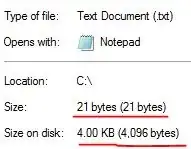This happens because harddisks are "block devices". That means you can only write data in units of complete "sectors" at a time, and you can only reserve space on the device in units of "sectors".
It is not possible to write 21 bytes, it is only possible to write a full block (or "sector") of which you effectively only use 21 bytes.
The actual sector size may vary from device to device, and it is mostly invisible (and not really important) to you. 512 bytes were common for decades, but newer drives have other sizes, usually 4096 bytes, to account for larger storage capacities.
Some drives (for example SSDs) are even more complicated internally, as they have physical allocation granularities of e.g. 512kiB but expose units of 4kiB to the outside world. To make this work at all, the drive internally (and without telling anyone) copies around data as needed. None of that is visible to the operating system or the user.
Now, since the device works that way, the operating system necessarily has to do something similar (in fact, not necessarily, but that is what is the only efficient way -- you could of course do it differently if you absolutely wanted, it just does not make much sense).
4096 is a good default "guess" for reasonably sized partitions because it is a multiple of all normally occurring device block sizes, and it does not waste too much space. Therefore, that is what NTFS (and most other file systems) uses as default, too. You can manually change this when formatting a drive, but usually this is not necessary and not advised.
For very large partitions, NTFS will use even bigger cluster sizes (8K upwards of 16TB, and 16k upwards of 32TB) as this keeps the cluster numbers smaller, and large drives can get over with wasting a few bytes on small files.
